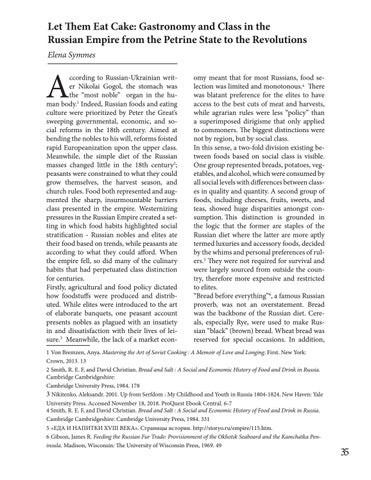Let Them Eat Cake: Gastronomy and Class in the Russian Empire from the Petrine State to the Revolutions Elena Symmes
A
ccording to Russian-Ukrainian writer Nikolai Gogol, the stomach was the “most noble” organ in the human body.1 Indeed, Russian foods and eating culture were prioritized by Peter the Great’s sweeping governmental, economic, and social reforms in the 18th century. Aimed at bending the nobles to his will, reforms foisted rapid Europeanization upon the upper class. Meanwhile, the simple diet of the Russian masses changed little in the 18th century2; peasants were constrained to what they could grow themselves, the harvest season, and church rules. Food both represented and augmented the sharp, insurmountable barriers class presented in the empire. Westernizing pressures in the Russian Empire created a setting in which food habits highlighted social stratification - Russian nobles and elites ate their food based on trends, while peasants ate according to what they could afford. When the empire fell, so did many of the culinary habits that had perpetuated class distinction for centuries. Firstly, agricultural and food policy dictated how foodstuffs were produced and distributed. While elites were introduced to the art of elaborate banquets, one peasant account presents nobles as plagued with an insatiety in and dissatisfaction with their lives of leisure.3 Meanwhile, the lack of a market econ-
omy meant that for most Russians, food selection was limited and monotonous.4 There was blatant preference for the elites to have access to the best cuts of meat and harvests, while agrarian rules were less “policy” than a superimposed dirigisme that only applied to commoners. The biggest distinctions were not by region, but by social class. In this sense, a two-fold division existing between foods based on social class is visible. One group represented breads, potatoes, vegetables, and alcohol, which were consumed by all social levels with differences between classes in quality and quantity. A second group of foods, including cheeses, fruits, sweets, and teas, showed huge disparities amongst consumption. This distinction is grounded in the logic that the former are staples of the Russian diet where the latter are more aptly termed luxuries and accessory foods, decided by the whims and personal preferences of rulers.5 They were not required for survival and were largely sourced from outside the country, therefore more expensive and restricted to elites. “Bread before everything”6, a famous Russian proverb, was not an overstatement. Bread was the backbone of the Russian diet. Cereals, especially Rye, were used to make Russian “black” (brown) bread. Wheat bread was reserved for special occasions. In addition,
1 Von Bremzen, Anya. Mastering the Art of Soviet Cooking : A Memoir of Love and Longing. First. New York: Crown, 2013. 13 2 Smith, R. E. F, and David Christian. Bread and Salt : A Social and Economic History of Food and Drink in Russia. Cambridge Cambridgeshire: Cambridge University Press, 1984. 178 3 Nikitenko, Aleksandr. 2001. Up from Serfdom : My Childhood and Youth in Russia 1804-1824. New Haven: Yale University Press. Accessed November 18, 2018. ProQuest Ebook Central. 6-7 4 Smith, R. E. F, and David Christian. Bread and Salt : A Social and Economic History of Food and Drink in Russia. Cambridge Cambridgeshire: Cambridge University Press, 1984. 331 5 «ЕДА И НАПИТКИ XVIII ВЕКА». Страницы истории. http://storyo.ru/empire/115.htm. 6 Gibson, James R. Feeding the Russian Fur Trade: Provisionment of the Okhotsk Seaboard and the Kamchatka Peninsula. Madison, Wisconsin: The University of Wisconsin Press, 1969. 49
35
